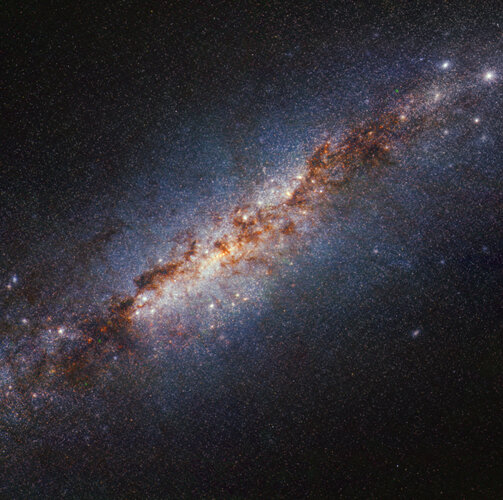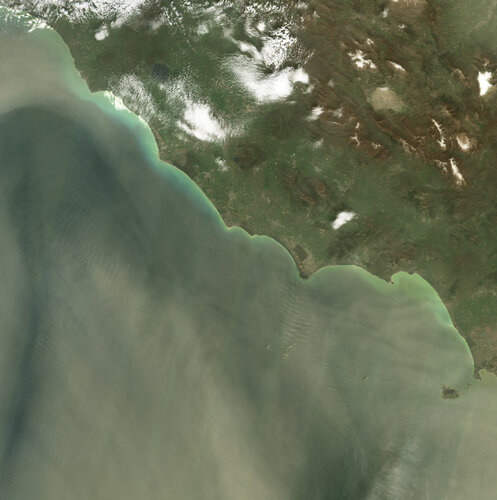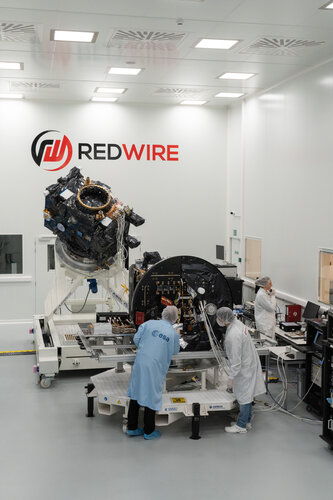With 10 on board ISS crew gets to work
Wednesday, 03 April 2024 13:53 The International Space Station (ISS) was a hive of activity on Tuesday, with its ten-member crew - consisting of five NASA astronauts, four Roscosmos cosmonauts, and one spaceflight participant from Belarus - dedicating their time to cargo operations, spacesuit upkeep, and a variety of scientific investigations. This day exemplified the collaborative spirit and scientific curiosity that propels
The International Space Station (ISS) was a hive of activity on Tuesday, with its ten-member crew - consisting of five NASA astronauts, four Roscosmos cosmonauts, and one spaceflight participant from Belarus - dedicating their time to cargo operations, spacesuit upkeep, and a variety of scientific investigations. This day exemplified the collaborative spirit and scientific curiosity that propels NASA and Boeing set new date for Starliner's first crewed mission
Wednesday, 03 April 2024 13:53 In light of a recent review of the International Space Station's (ISS) busy schedule, the first manned flight of the CST-100 Starliner, a part of NASA's Boeing Crew Flight Test, is now slated for no earlier than May 6.
This rescheduling is aimed at better aligning with the ISS's end-of-April activities, which include the departure of a cargo spacecraft and the repositioning of a crew space
In light of a recent review of the International Space Station's (ISS) busy schedule, the first manned flight of the CST-100 Starliner, a part of NASA's Boeing Crew Flight Test, is now slated for no earlier than May 6.
This rescheduling is aimed at better aligning with the ISS's end-of-April activities, which include the departure of a cargo spacecraft and the repositioning of a crew space Lockheed Martin Ventures Backs Helicity Space for Fusion Propulsion Advancements
Wednesday, 03 April 2024 13:53 Helicity Space, a trailblazer in fusion power for in-space propulsion and power technology, has garnered investment from Lockheed Martin Ventures, signaling a significant endorsement from the aerospace titan's venture capital wing.
Following a $5 million seed investment round in December, featuring contributions from Airbus Ventures, TRE Ventures, Voyager Space Holdings, E2MC Space, Urania
Helicity Space, a trailblazer in fusion power for in-space propulsion and power technology, has garnered investment from Lockheed Martin Ventures, signaling a significant endorsement from the aerospace titan's venture capital wing.
Following a $5 million seed investment round in December, featuring contributions from Airbus Ventures, TRE Ventures, Voyager Space Holdings, E2MC Space, Urania VIPER rover hoists its Mast ahead of lunar mission
Wednesday, 03 April 2024 13:53 The NASA Volatiles Investigating Polar Exploration Rover, better known as VIPER, now boasts enhanced capabilities and a taller stature, courtesy of its newly raised mast. This mast, acting as the rover's "neck" and "head," is equipped with a comprehensive suite of instruments. These tools will aid the rover team, consisting of drivers and scientists operating in real-time, in navigating the luna
The NASA Volatiles Investigating Polar Exploration Rover, better known as VIPER, now boasts enhanced capabilities and a taller stature, courtesy of its newly raised mast. This mast, acting as the rover's "neck" and "head," is equipped with a comprehensive suite of instruments. These tools will aid the rover team, consisting of drivers and scientists operating in real-time, in navigating the luna Continuing up the Channel: Sols 4139-4140
Wednesday, 03 April 2024 13:53 Earth planning date: Wednesday, March 27, 2024: As someone who studies planetary atmospheres, the geology of Curiosity's mission often flies straight over my head. I like to think that I've picked up some of the basics just through exposure, but sitting in with the geology team at the start of planning each day can sometimes still leave me feeling like I've forgotten how to swim seconds before b
Earth planning date: Wednesday, March 27, 2024: As someone who studies planetary atmospheres, the geology of Curiosity's mission often flies straight over my head. I like to think that I've picked up some of the basics just through exposure, but sitting in with the geology team at the start of planning each day can sometimes still leave me feeling like I've forgotten how to swim seconds before b Asteroid Bennu's samples available for global scientific scrutiny
Wednesday, 03 April 2024 13:53 In a significant advancement for space research, NASA's OSIRIS-REx team has made the asteroid Bennu samples accessible for global scientific investigation, a mere six months following their Earth arrival. Managed by NASA's Johnson Space Center, the unveiling of the OSIRIS-REx sample catalog marks a key moment, offering researchers worldwide the opportunity to delve into the composition of these
In a significant advancement for space research, NASA's OSIRIS-REx team has made the asteroid Bennu samples accessible for global scientific investigation, a mere six months following their Earth arrival. Managed by NASA's Johnson Space Center, the unveiling of the OSIRIS-REx sample catalog marks a key moment, offering researchers worldwide the opportunity to delve into the composition of these In first, US directs NASA to create lunar time standard
Wednesday, 03 April 2024 13:53 The White House announced Tuesday it is directing NASA to create a unified time standard for the Moon and other celestial bodies, as governments and private companies increasingly compete in space.
With the United States keen to set international norms beyond Earth's orbit, the White House Office of Science and Technology Policy (OSTP) instructed the US space agency to formulate a plan by th
The White House announced Tuesday it is directing NASA to create a unified time standard for the Moon and other celestial bodies, as governments and private companies increasingly compete in space.
With the United States keen to set international norms beyond Earth's orbit, the White House Office of Science and Technology Policy (OSTP) instructed the US space agency to formulate a plan by th An Intriguing Mess: Sols 4141-4143
Wednesday, 03 April 2024 13:53 Earth planning date: Friday, March 29, 2024: Curiosity is approaching an intriguing pile of rocks called "Hinman Col" - a poorly sorted collection of clasts located along the margin of Gediz Vallis ridge. We're hoping to get closer to this deposit over the weekend, to set up for contact science on the different rock types next week. In doing so, we hope to investigate where the different clasts
Earth planning date: Friday, March 29, 2024: Curiosity is approaching an intriguing pile of rocks called "Hinman Col" - a poorly sorted collection of clasts located along the margin of Gediz Vallis ridge. We're hoping to get closer to this deposit over the weekend, to set up for contact science on the different rock types next week. In doing so, we hope to investigate where the different clasts The Persistent Ices of Kuiper Belt Object 486958 Arrokoth
Wednesday, 03 April 2024 13:53 Scientists at Brown University, in collaboration with the SETI Institute, have unveiled findings from a new study that may rewrite the narrative on the behavior and composition of distant solar system objects, particularly a Kuiper Belt Object known as 486958 Arrokoth, affectionately dubbed the "space snowman."
The research highlights Arrokoth's ability to retain ancient ices within its co
Scientists at Brown University, in collaboration with the SETI Institute, have unveiled findings from a new study that may rewrite the narrative on the behavior and composition of distant solar system objects, particularly a Kuiper Belt Object known as 486958 Arrokoth, affectionately dubbed the "space snowman."
The research highlights Arrokoth's ability to retain ancient ices within its co Webb Telescope unveils first glimpse into planetary formation
Wednesday, 03 April 2024 13:53 In a major stride for astronomy, scientists utilizing the Webb Telescope, equipped with advanced infrared technology partly developed by the University of Arizona, have captured the first direct views of the materials shaping a young planetary system. This research is directly helping our understanding of how planets emerge from the dense interstellar dust and gas.
At the UArizona Steward
In a major stride for astronomy, scientists utilizing the Webb Telescope, equipped with advanced infrared technology partly developed by the University of Arizona, have captured the first direct views of the materials shaping a young planetary system. This research is directly helping our understanding of how planets emerge from the dense interstellar dust and gas.
At the UArizona Steward AI at the crossroads of cybersecurity, space and national security in the digital age
Wednesday, 03 April 2024 13:30
Webb probes galaxy teeming with newborn stars
Wednesday, 03 April 2024 13:00
The NASA/ESA/CSA James Webb Space Telescope has set its sights on the starburst galaxy Messier 82 (M82), a small but mighty environment that features rapid star formation. By looking closer with Webb’s sensitive infrared capabilities, a team of scientists is getting to the very core of the galaxy, gaining a better understanding of how it is forming stars and how this extreme activity is affecting the galaxy as a whole.
Saharan dust plume
Wednesday, 03 April 2024 12:40 Image:
Images from the Copernicus Sentinel-2 mission show a large dust storm originating from the Sahara Desert that has engulfed skies across the central Mediterranean Basin.
Image:
Images from the Copernicus Sentinel-2 mission show a large dust storm originating from the Sahara Desert that has engulfed skies across the central Mediterranean Basin. ESA's solar eclipse maker, Proba-3
Wednesday, 03 April 2024 11:40
Hundreds of millions of people will witness next week’s total solar eclipse across North America, and solar physicists from around the globe are flocking to join them. Eclipses offer a brief glimpse of the Sun’s ghostly surrounding atmosphere – the solar corona – normally kept invisible by the Sun’s sheer glare. But the corona will soon be opened up for more sustained study: today in Belgium ESA has unveiled the pair of spacecraft making up its new Proba-3 mission, planned to produce orbital solar eclipse events on demand.



